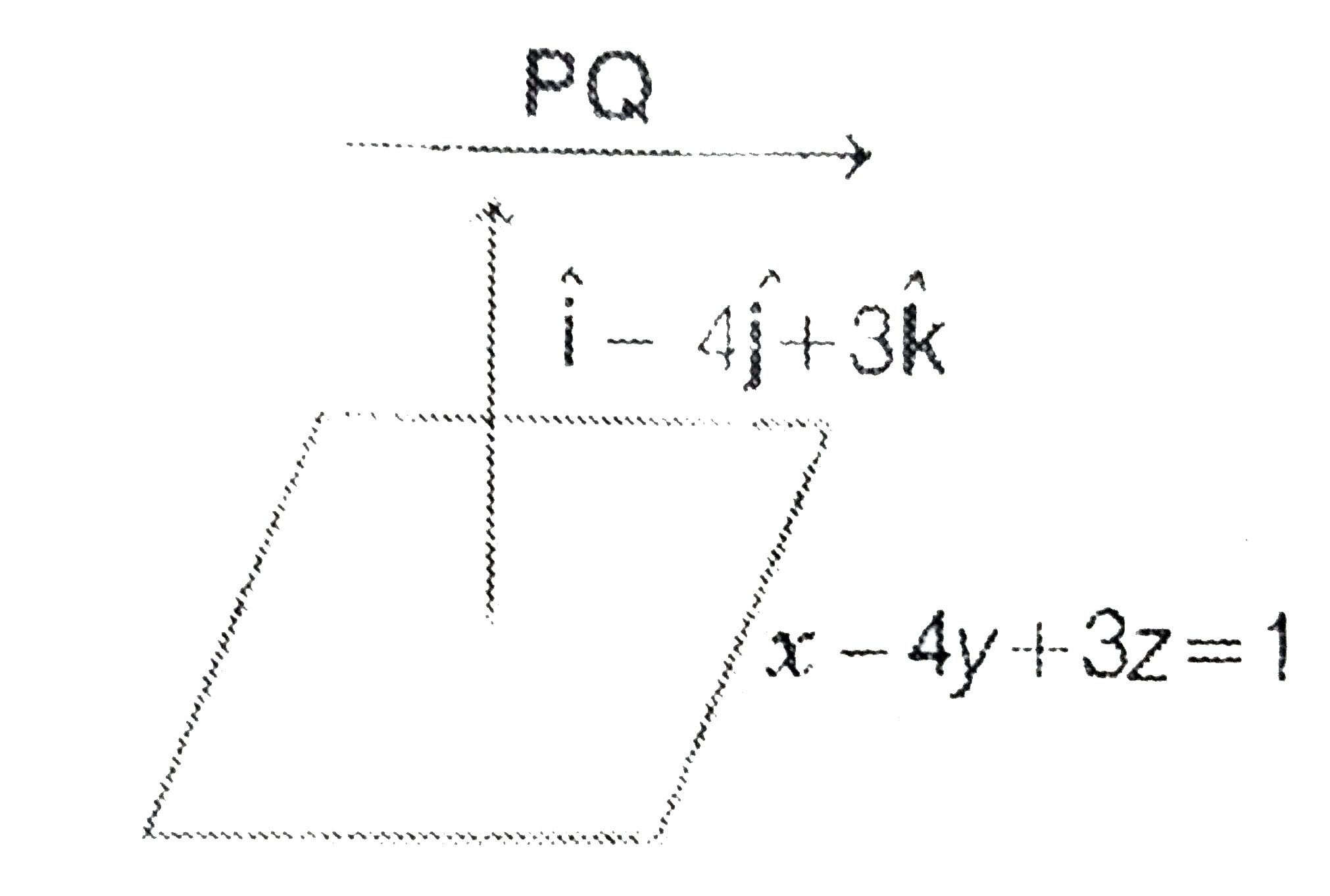Let P(3,2,6) be a point in space and Q be a point on line →r=(ˆi−ˆj+2ˆk)+μ(−3ˆi+ˆj+5ˆk). Then the value of μ for which the vector →PQ is parallel to the plane x−4y+3z=1 is a. 1/4 b. -1/4 c. 1/8 d. -1/8
14
−14
18
−18
The correct Answer is:A
Given, OQ=(1−3μ)ˆi+(μ−1)ˆj+(5μ+2)ˆk
and OP=3ˆi+2ˆj+6ˆk [where, O is origin]

Now, PQ=(1−3μ−3)ˆi+(μ−1−2)ˆj+(5μ+2−6)ˆk
=(−2−3μ)ˆi+(μ−3)ˆj+(5μ−4)ˆk
∵PQ is parallel to the plane x−4y+3z=1.
∴−2−3μ−4μ+12+15μ−12=0
⇒ 8μ=2⇒μ=14
Topper's Solved these Questions
- 3D GeometryBOOK - IIT JEE PREVIOUS YEARCHAPTER - 3D GeometryEXERCISE - Equation of Plane Objective Question II (One or more than pne correct option)
5 Videos
- 3D GeometryBOOK - IIT JEE PREVIOUS YEARCHAPTER - 3D GeometryEXERCISE - Equation of Plane Objective Question II (Numerical Value)
1 Videos
- 3D GeometryBOOK - IIT JEE PREVIOUS YEARCHAPTER - 3D GeometryEXERCISE - Straight Line in Space and Shortest Distance Objective Question II (One or more than one correct option)
3 Videos
- PROPERTIES OF TRIANGLESBOOK - IIT JEE PREVIOUS YEARCHAPTER - PROPERTIES OF TRIANGLESEXERCISE - CIRCUMCIRCLE, INCIRCLE, ESCRIBED CIRCLE, ORTHOCENTRE,INCENTRE AND CIRCUMCENTRE
20 Videos
- APPLICATION OF DERIVATIVES BOOK - IIT JEE PREVIOUS YEARCHAPTER - APPLICATION OF DERIVATIVES EXERCISE - MAXIMA AND MINIMA ( INTEGER ANSWER TYPE QUESTIONS)
8 Videos
Similar Questions
Let P(3,2,6) be a point in space and Q be a point on line →r=(ˆi−ˆj+2ˆk)+μ(−3ˆi+ˆj+5ˆk). Then the value of μ for which the vector →PQ is parallel to the plane x−4y+3z=1 is a. 1/4 b. -1/4 c. 1/8 d. -1/8
View SolutionA point on the line →r=2ˆi+3ˆj+4ˆk+t(ˆi+ˆj+ˆk) is
View SolutionLet A be a point on the line →r=(1−3μ)ˆi+(μ−1)ˆj+(2+5μ)ˆk and B(3,2,6) be a point in the space. Then the value of μ for which the vector −−→AB is parallel to the plane x−4y+3z=1 is: (a) 18 (b) 12 (c) 14 (d) −14
View Solution→r=(4ˆi−ˆj)+λ(ˆi+2ˆj−3ˆk)and→r=(ˆi−ˆj+2ˆk)+μ(2ˆi+4ˆj−5ˆk)
View SolutionIf line →r=(ˆi−2ˆj−ˆk)+λ(2ˆi+ˆj+2ˆk) is parallel to the plane →r.(3ˆi−mˆk)=14 , then the value of m is
(1).2
(2) −2
(3)0
(4)3
View SolutionIf →a=ˆi+ˆj+ˆk, →b=2ˆi−ˆj+3ˆk and →c=ˆi−2ˆj+ˆk find a unit vector parallel to 2→a−→b+3→⋅
View SolutionIf →a=ˆi+ˆj+ˆk,→b=2ˆi−ˆj+3ˆkand→c=ˆi−2ˆj+ˆk find a unit vector in a direction parallel to vector (2→a−→b+3→c)
View SolutionIf →a=3ˆi−ˆj−4ˆk, →b=−2ˆi+4ˆj−3ˆk and →c=ˆi+2ˆj−ˆk, find ∣∣3→a−2→b+4→c∣∣.
View SolutionIf →a=3ˆi−ˆj−4ˆk, →b=−2ˆi+4ˆj−3ˆk and →c=ˆi+2ˆj−ˆk,find ∣∣3→a−2→b+4→c∣∣.
View SolutionFind the angle between the line:
→r=(ˆi−ˆj+ˆk)+λ(2ˆi−ˆj+3ˆk) and the plane →r.(2ˆi+ˆj−ˆk)=4.
Also, find the whether the line is parallel to the plane or not.
View Solution
